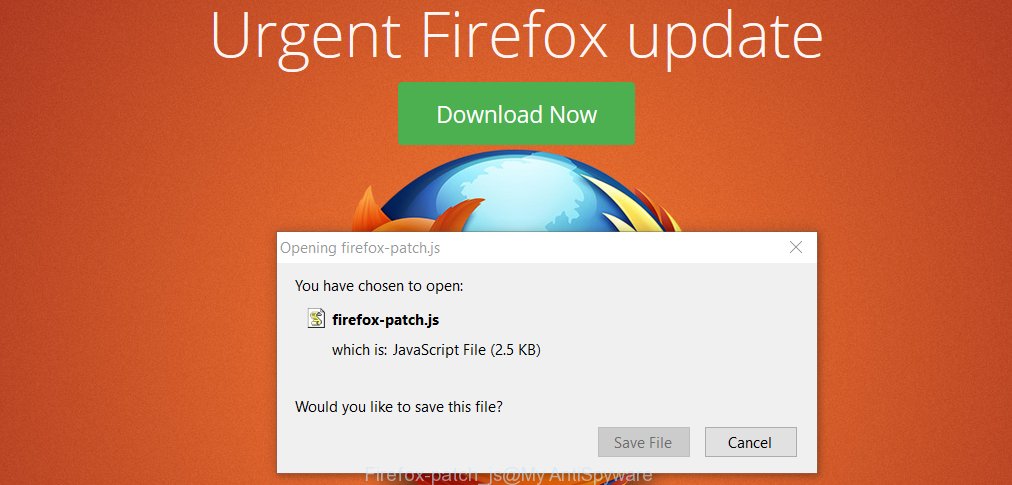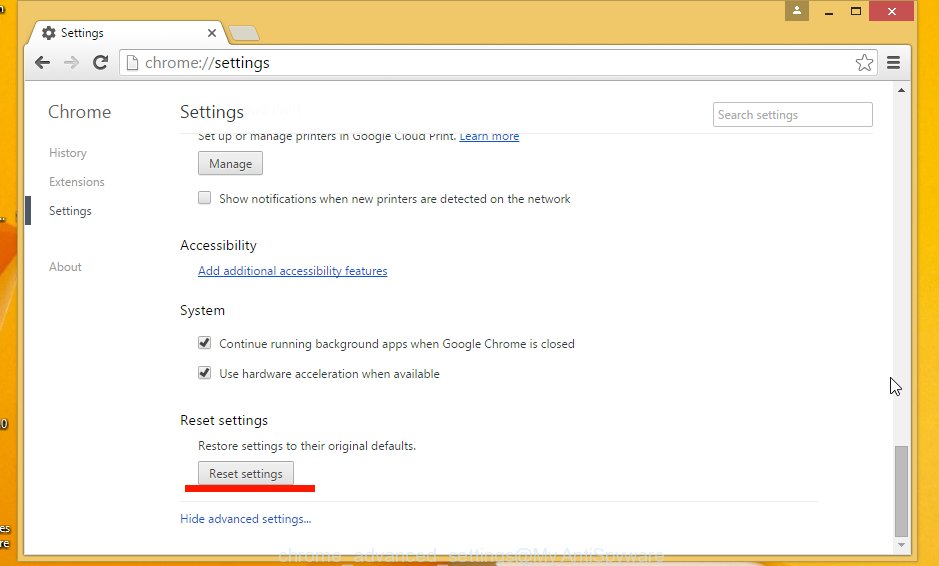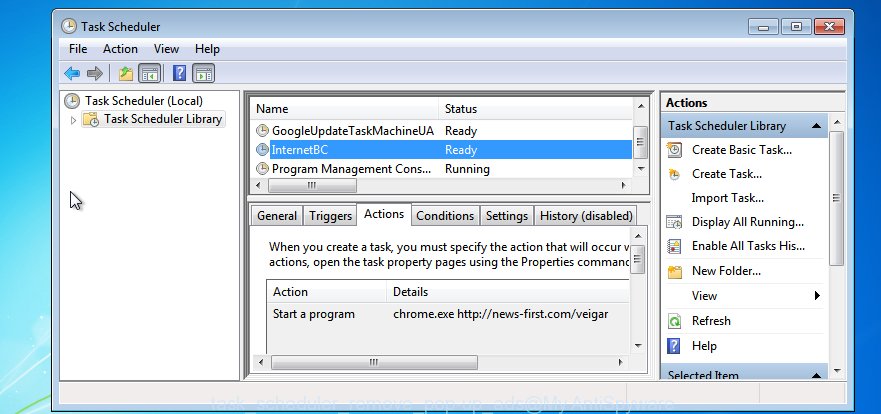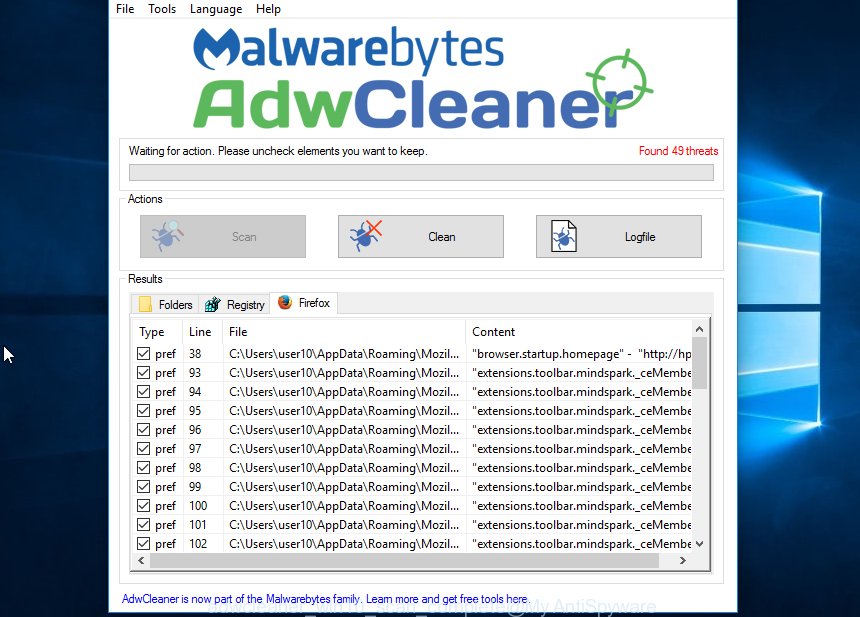Have you become that your Mozilla Firefox web browser randomly displays unwanted popups asking install Firefox-patch.js? It is a sign that you have an installed adware (also known as ‘ad-supported’ software) on your PC system. The adware is a part of dangerous software that created to display a ton of unwanted pop-up ads. Perform the steps below ASAP. It will clear your machine from ad supported software that generates a huge number of popup ads in the web-browser and thereby remove the redirect to Firefox-patch.js page.

Most often, the ‘ad supported’ software affects the most common browsers like the Google Chrome, Firefox, Edge and IE. But such the dangerous software as well may infect another internet browsers by changing its shortcuts (adding an argument like ‘http://site.address’ into Target field of a web browser’s shortcut). So every time you start the browser, it’ll reroute to the unwanted Firefox-patch.js web page. Even if you setup a new start page, an unwanted web page will be the first thing you see when you launch the Chrome, FF, Internet Explorer and Microsoft Edge.
The adware may insert a large amount of ads directly to the sites that you visit, creating a sense that the advertisements has been added by the creators of the site. Moreover, a legal advertising links may be replaced on the fake ads, that will offer to download and install various unnecessary and harmful programs. Moreover, the adware has the ability to collect a lot of personal information about you (your ip address, what is a web page you are viewing now, what you are looking for on the World Wide Web, which links you are clicking), which can later transfer to third parties.
Therefore it is very important to follow the step-by-step instructions below as soon as possible. The step-by-step guide will assist you to get rid of adware as well as clean your system from the Firefox-patch.js pop-up. What is more, the step-by-step instructions below will help you get rid of other malicious software like unwanted toolbars and browser hijackers, which could penetrate the system along with the adware.
How to Firefox-patch.js popup ads get installed onto PC
The adware spreads with a simple but quite effective way. It is integrated into the installation package of various freeware. Thus on the process of installation, it will infect your web browser. To avoid ‘ad supported’ software infection, you just need to follow a few simple rules: carefully read the ‘Terms of Use’ and the ‘License’, select only a Manual, Custom or Advanced install mode, which enables you to make sure that the program you want to install, thereby protect your machine from the malicious software like this ‘ad supported’ software that opens the Firefox-patch.js pop-up.
How to manually remove Firefox-patch.js pop-up malware
If you perform exactly the steps below you should be able to delete the Firefox-patch.js pop-up malware. Read it once, after doing so, please print this page as you may need to close your browser or reboot your PC system.
- Uninstall suspicious and unknown software by using Windows Control Panel
- Disinfect the browser’s shortcuts to remove Firefox-patch.js redirect
- Remove Firefox-patch.js redirect from Mozilla Firefox
- Remove unwanted pop-ups from Chrome
- Remove annoying pop-up ads from Internet Explorer
- Delete unwanted Scheduled Tasks
Uninstall suspicious and unknown software by using Windows Control Panel
We recommend that you begin the computer cleaning process by checking the list of installed applications and delete all unknown or suspicious applications. This is a very important step, as mentioned above, very often the malicious programs such as adware and browser hijackers may be bundled with freeware. Uninstall the unwanted programs may remove the annoying ads or browser redirect to unknown or annoying sites.
Windows 8, 8.1, 10
Press Windows key
Windows XP, Vista, 7
First, click “Start” and select “Control Panel”.
It’ll display the Windows Control Panel as on the image below.

Next, click “Uninstall a program” ![]()
It will open a list of all software. Scroll through the all list, and delete any suspicious and unknown software. To quickly find the latest installed software, we recommend sort applications by date of installation in the Control panel.
Disinfect the browser’s shortcuts to remove Firefox-patch.js redirect
Once the adware is started, it can also alter the browser’s shortcuts, adding an argument like “http://site.address” into the Target field. Due to this, every time you run the web browser, it will be rerouted to an annoying ads.
To clear the browser shortcut, right-click to it and select Properties. On the Shortcut tab, locate the Target field. Click inside, you will see a vertical line – arrow pointer, move it (using -> arrow key on your keyboard) to the right as possible. You will see a text that begins with “http://” that has been added here. You need to remove it.

When the argument is removed, click the OK button. You need to clean all shortcuts of all your internet browsers, as they may be infected too.
Remove Firefox-patch.js redirect from Mozilla Firefox
First, launch the Firefox. Next, press the button in the form of three horizontal stripes (![]() ). It will open the drop-down menu. Next, press the “Help” button (
). It will open the drop-down menu. Next, press the “Help” button (![]() ).
).

In the Help menu, press the “Troubleshooting Information”. In the upper-right corner of the “Troubleshooting Information” page, click “Refresh Firefox” button.

Confirm your action, click the “Refresh Firefox”.
Remove unwanted pop-ups from Chrome
Like other modern web-browsers, the Google Chrome has the ability to reset the settings to their default values and thereby remove the redirect to Firefox-patch.js unwanted advertisements which is caused by the adware.
At first, start the Chrome. Next, click the button in the form of three horizontal stripes (![]() ). It will appear the main menu. Click on the option named “Settings”. Another way to display the Chrome’s settings – type chrome://settings in the browser adress bar and press Enter.
). It will appear the main menu. Click on the option named “Settings”. Another way to display the Chrome’s settings – type chrome://settings in the browser adress bar and press Enter.

The web-browser will display the settings screen. Scroll down to the bottom of the page and click on the “Show advanced settings” link. Now scroll down until the “Reset settings” section is visible, as shown on the screen below and click the “Reset settings” button.

The Chrome will open the confirmation prompt. You need to confirm your action, click the “Reset” button. The program will start the process of cleaning. Once it’s complete, the browser settings including the ‘block pop-ups’ option back to the values that have been when the Chrome was first installed on your computer.
Remove annoying pop-up ads from Internet Explorer
First, run the Internet Explorer, then press ![]() button. Next, click “Internet Options” as on the image below.
button. Next, click “Internet Options” as on the image below.

In the “Internet Options” screen select the Advanced tab. Next, press the “Reset” button. The Internet Explorer will open the “Reset Internet Explorer” settings prompt. Select the “Delete personal settings” check box and press Reset button.

You will now need to reboot your system for the changes to take effect. It will restore the IE’s settings like homepage, new tab page and search engine by default to default state, disable ad-supported web-browser’s extensions and thereby remove annoying pop-up ads.
Delete unwanted Scheduled Tasks
If the unwanted page asking install Firefox-patch.js malware opens automatically on Windows startup or at equal time intervals, then you need to check the Task Scheduler Library and remove all the tasks that have been created by adware.
Press Windows and R keys on the keyboard at the same time. This displays a prompt that titled with Run. In the text field, type “taskschd.msc” (without the quotes) and click OK. Task Scheduler window opens. In the left-hand side, click “Task Scheduler Library”, as shown in the figure below.

Task scheduler
In the middle part you will see a list of installed tasks. Select the first task, its properties will be open just below automatically. Next, click the Actions tab. Pay attention to that it launches on your machine. Found something like “explorer.exe http://site.address” or “chrome.exe http://site.address”, then you need delete it. If you are not sure that executes the task, check it through a search engine. If it is a component of the ‘ad-supported’ programs, then this task also should be removed.
Having defined the task that you want to remove, then press on it with the right mouse button and select Delete as shown in the figure below.

Delete a task
Repeat this step, if you have found a few tasks that have been created by malicious program. Once is finished, close the Task Scheduler window.
How to remove Firefox-patch.js virus with free malware remover
Remove Firefox-patch.js pop-up malware manually is difficult and often the ad supported software is not completely removed. Therefore, we recommend you to use the Malwarebytes Free that are completely clean your personal computer. Moreover, the free program will help you to remove malware, web-browser hijacker and toolbars that your personal computer may be infected too.
- Download Malwarebytes by clicking on the link below.
Malwarebytes Anti-malware
327002 downloads
Author: Malwarebytes
Category: Security tools
Update: April 15, 2020
- Close all programs and windows on your personal computer. Open the directory in which you saved it. Double-click on the icon that’s named mb3-setup.
- This will launch the installation of Malwarebytes. Next, click Next button and follow the prompts.
- When installation is finished, press on the “Scan Now” button to perform a system scan for the adware which redirects your web browser to the Firefox-patch.js annoying web site. This procedure can take some time, so please be patient.
- Once the system scan is done, make sure all entries have “checkmark” and click “Quarantine Selected”. When the disinfection is finished, you may be prompted to restart your computer.
These steps above are shown in detail in the following video guide.
How to block Firefox-patch.js pop-up
To increase your security and protect your machine against new unwanted advertisements and malicious sites, you need to use an application that stops access to harmful ads and pages. Moreover, the application can stop the display of intrusive advertising, that also leads to faster loading of web-sites and reduce the consumption of web traffic.
- Download AdGuard application by clicking on the following link.
Adguard download
26826 downloads
Version: 6.4
Author: © Adguard
Category: Security tools
Update: November 15, 2018
- After downloading is finished, run the downloaded file. You will see the “Setup Wizard” window. Follow the prompts.
- Once the setup is complete, click “Skip” to close it and use the default settings, or press “Get Started” to see a quick tutorial that will allow you get to know AdGuard better.
- In most cases, the default settings are enough and you do not need to change anything. Each time, when you run your computer, AdGuard will start automatically and stop popup ads, Firefox-patch.js redirects, as well as other harmful or misleading web pages. For an overview of all the features of the program, or to change its settings you can simply double-click on the AdGuard icon, that is located on your Windows desktop.
Scan your PC system and get rid of Firefox-patch.js virus with AdwCleaner.
This removal program is free and easy to use. It can scan and remove ‘ad supported’ software, browser hijackers, malware and unwanted toolbars in Chrome, FF, Internet Explorer and Microsoft Edge internet browsers and thereby restore back their default settings (startpage, new tab page and default search engine). AdwCleaner is powerful enough to find and delete malicious registry entries and files that are hidden on the PC.
Download AdwCleaner utility from the link below. Save it to your Desktop so that you can access the file easily.
225513 downloads
Version: 8.4.1
Author: Xplode, MalwareBytes
Category: Security tools
Update: October 5, 2024
Once downloading is finished, open the file location and double-click the AdwCleaner icon. It will start the AdwCleaner utility and you will see a screen as shown in the figure below. If the User Account Control prompt will ask you want to display the program, press Yes button to continue.

Now, click the “Scan” for checking your PC for the adware that cause a redirect to Firefox-patch.js misleading web site.

When it has finished scanning, it will open a list of all items detected by this tool as shown in the figure below.

You need to click “Clean” button. It will open a prompt, click “OK” to begin the cleaning process. When the clean up is complete, the AdwCleaner may ask you to restart your computer. After reboot, the AdwCleaner will show the log file.
All the above steps are shown in detail in the following video guide.
Finish words
Now your computer should be free of the Firefox-patch.js pop-ups. Remove AdwCleaner. We suggest that you keep AdGuard (to help you block unwanted popup ads and annoying malicious web-pages) and Malwarebytes (to periodically scan your machine for new malware and ad-supported software). Probably you are running an older version of Java or Adobe Flash Player. This can be a security risk, so download and install the latest version right now.
If you are still having problems while trying to delete Firefox-patch.js redirects from your PC, then ask for help in our Spyware/Malware removal forum.


















